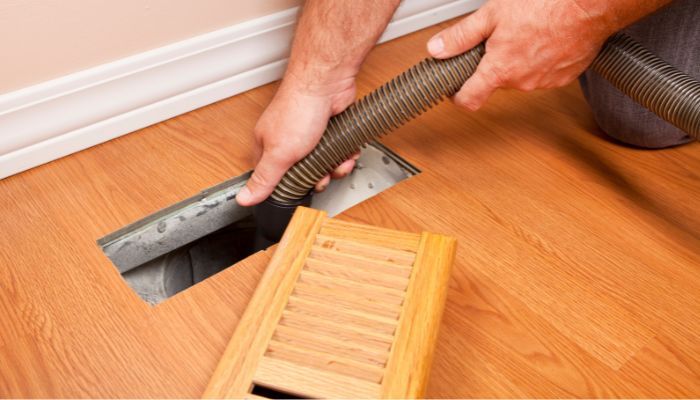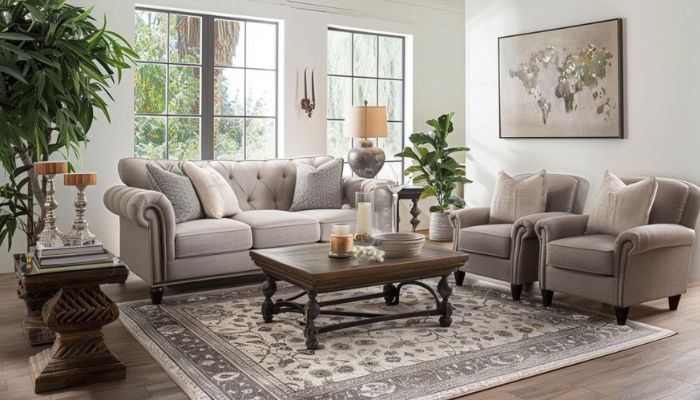Fresh Start to the New Year: Revitalizing Your Upholstery

TLDR: Upholstery cleaning is crucial for maintaining furniture and fabric appearance, promoting a healthier environment, and safeguarding against allergens and dust mites. Regular cleaning is essential to prevent dirt buildup, extend fabric life, and protect against allergies. Upholstery revitalization can be done through DIY methods or by hiring professional services, with each approach having its own advantages and considerations. Prolonging upholstery life involves routine vacuuming, spot cleaning, and protective measures like fabric sprays. Clean upholstery offers health benefits by reducing allergens, bacteria, and mold, thus contributing to a cleaner and safer living space. Regular cleaning, whether DIY or professional, is essential for preserving upholstery and ensuring a healthy environment.
Upholstery cleaning is essential for maintaining the look and feel of both furniture and fabrics and is the key to achieving a new look, preserving the fabric’s vibrancy, and promoting a healthier atmosphere in a home. Professional upholstery revitalization by trained experts is recommended for optimal results; however, those looking to undertake a DIY method can gain beneficial results without the cost of professional help. Knowing proper cleaning techniques and products is a must for those looking for the best outcome to prolong the life of their upholstery and safeguard their health from allergens and dust mites settled deep in fabric fibers.
The Importance of Upholstery Cleaning for a New Look
Upholstery cleaning is an important part of any home or office cleaning routine, as it keeps furniture looking new and attractive. Furthermore, regular upholstery cleaning guards against the accumulation of dirt, dust, and other debris that could build up over time, eventually impacting the longevity of a piece of furniture’s fabric. As a result, when it comes to the longevity and aesthetic of a piece of furniture’s upholstery, regular cleaning is key.
In addition to ensuring that a piece of furniture looks its best, regular upholstery cleaning also offers several health benefits. For instance, when furniture remains uncleaned, dust and dirt buildup can cause problems for people who suffer from allergies or asthma. By keeping upholstery cleaned and regularly vacuumed, these allergens can be significantly reduced, which can help protect their overall health.
However, upholstery cleaning isn’t just important to overall health and appearance; it’s also important to the lifespan of the fabric itself. Regular cleaning helps to remove any embedded debris that could cause damage to a piece of furniture’s upholstery, as it can weaken the fabric over time. Therefore, if regular cleaning is not performed, a piece of furniture’s fabric may need to be replaced sooner than expected.
Consequently, it is important to factor upholstery cleaning into your home or office cleaning routine. Implementing regular cleanings every few months can help keep a piece of furniture looking new, while also ensuring that it remains healthy and that the fabric remains undamaged and durable for years to come.
DIY Methods vs. Professional Upholstery Revitalization
Upholstery revitalization can be accomplished either through DIY methods or through the engagement of a professional upholstery service provider. DIY methods of upholstery revitalization usually involve the use of a store-bought cleaner and fabric protectant, as well as a brush or vacuum attachment. This method is often preferred by those who are concerned about the cost, as it can be completed for usually less cost than hiring a professional service. Furthermore, a DIY approach may be a practical choice if the upholstery requires only minor cleaning or protection.
On the other hand, if the upholstery is in need of more comprehensive revitalization, it may be more worth investing in the services of a professional upholstery service provider. Professional services often provide deep cleaning and fabric protection for the upholstered furniture, as well as an inspection for any potential damage or worn fabrics. Additionally, such services are often able to repair any upholstery issues and can offer advice on the best ways to extend the life of the furniture. Professional service like Cleaner Choice providers have access to more strenuous cleaners and treatment products, which may be more effective than store bought products.
In contrast to DIY methods, engaging a professional service can be more expensive, though it may be worth the cost in the long run. Yet if cost is a major concern, there are many ways to find affordable upholstery services through online resources or local businesses. Similarly, DIY methods may also prove more expensive if the upholstery requires materials that are not easily found in a store. As a result, potential clients should weigh the tradeoffs between cost and quality when deciding on a method for upholstery revitalization.
Overall, the decision on whether to use DIY methods or to engage a professional upholstery service should be based on the condition of the piece in question, as well as the desired quality of revitalization. Careful consideration of these factors is key to ensuring the best possible outcome for upholstery restoration.
Prolonging the Life and Vibrancy of Your Upholstery
Taking the proper precautions to ensure that your upholstery lasts as long as possible is essential for preserving the vibrancy of your furniture. Arguably the most important step is to routinely vacuum the piece, as dust and debris can accumulate in a short amount of time and can cause the upholstery to wear over time. It is beneficial to spot clean the upholstery using soap, water, and a cloth, and to cover the piece with a slipcover or throw when it isn’t in use. On the other hand, it is imperative to never scrub the furniture when it is wet, as this could ruin the fabric and make it fade in color. Similarly, it is important to avoid direct sunlight that can also cause fading, as it can penetrate through thin windows or during the daytime.
In addition, to ward off dirt, spills, and grime building up, consider applying a protective fabric spray after the piece has been vacuumed and spot cleaned. It is useful to take the furniture off the frame to clean it, and potentially re-stuff the cushioning material if necessary. For instance, this helps pull out dirt and dust from between the different fabrics. As a result, it can help preserve the upholstery and vibrancy of the furniture, as well as restoring the fabric’s feel and springiness. Consequently, taking care of your furniture with regular maintenance will ensure that it stands the test of time.
The Health Benefits of Clean Upholstery
Upholstery is an integral part of any home, office, or public space. It adds a layer of comfort, beauty, and style to the environment around us. However, it also requires maintenance to ensure it’s kept looking at its best and to prevent the buildup of debris, grime, and other allergens. Clean upholstery can provide a number of health benefits.
Firstly, upholstery can be a refuge for dust and dust mites. If left unclean for an extended period, the fabric material of the upholstery can become entangled with dust and dust mites, which can aggravate allergies or health conditions. Vacuuming and steam cleaning on a regular basis can help to limit this buildup and reduce the prevalence of these health issues.
In addition, regularly cleaning the fabric surface of upholstered pieces helps to remove debris and bacteria that have embedded themselves in the furniture, thereby reducing the risk of Texas Flu, colds, and other contagious illnesses. A thorough cleaning every few weeks can help to prevent these illnesses from spreading. When upholstered furniture is kept clean, the accumulation of fungus and mold growth is reduced, further limiting potential health hazards in the home.
In contrast, dirty upholstery can lead to an increase in the presence of allergens like pet dander, dust, and other pollutants in the air. Vacuuming and steam cleaning can help to reduce the risk of an allergic reaction by removing the allergens from the upholstery fabric. Similarly, fabric protection treatments can help to create a barrier that prevents foreign substances from building up and becoming airborne.
Therefore, it’s important for individuals to practice regular upholstery cleaning to ensure their health isn’t worse off because of dirt and grime buildup on furniture. Clean upholstery not only reduces the risk of allergens and bacteria, but can also help to maintain the beauty of furniture for a longer period of time. As a result, taking the time to clean regularly is essential for maintaining a healthy and clean space. Consequently, it’s best to keep upholstery clean to ensure its longevity and the health of those living in or using the space.
Final Thoughts
Overall, upholstery care is essential if you want to enjoy vibrant, healthy upholstery that lasts long and looks new. The key is to get them cleaned on a regular basis, no matter if you prefer to do it yourself or you choose to go for professional upholstery revitalization. Professional cleaning is the most effective method for lasting and optimal results, as it consists of deep-cleaning and powerful treatments that can reach and eliminate bacteria, molds, pollen, and dust mites while also providing fabric protection, stain removal, and deodorizing capabilities. In addition, keeping your upholstery clean will protect your health, as the allergens and germs that have descended on them can cause respiratory problems, itchy eyes, and sneezing or coughing fits.
Frequently Asked Questions
How often should upholstery be professionally cleaned?
It is recommended to have your upholstered furniture professionally cleaned every 12 to 18 months.
Can revitalizing my upholstery improve its lifespan?
Yes, revitalizing your upholstery can improve its lifespan. Revitalizing your upholstery is a process of cleaning and disinfecting the material, which can remove any dirt, debris, or pet hair that may be hindering its lifespan. Additionally, conditioning your upholstery helps protect the fabric from damage due to sun, wear, or other contaminated elements.
What common household spills are toughest on upholstery?
Common household spills that are toughest on upholstery are those that contain dye or ink, such as coffee, tea, red wine, and food coloring. Dark-colored liquids are especially difficult to remove from upholstery as they can stain the material and cause permanent discoloration.
Is it safe to use store-bought upholstery cleaners?
Yes, store-bought upholstery cleaners are generally safe to use. Always check the instructions on the label and follow the directions carefully for the best and safest cleaning results.






